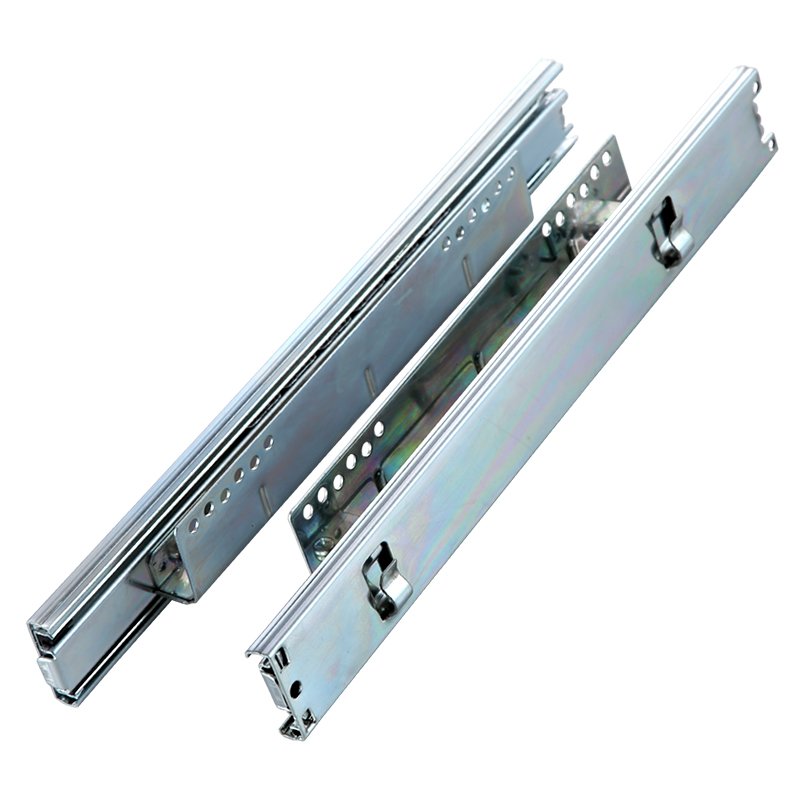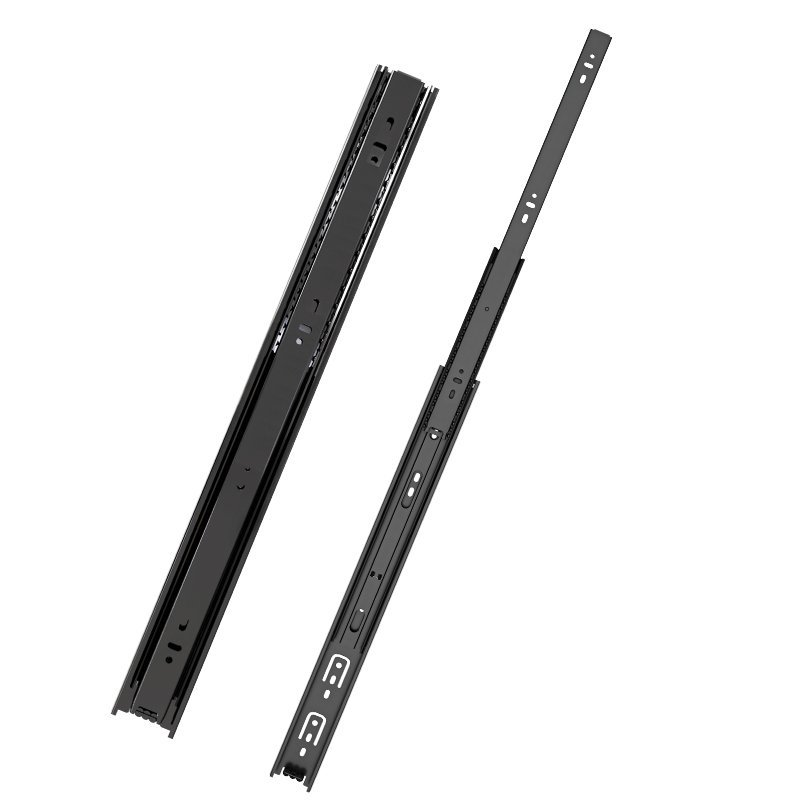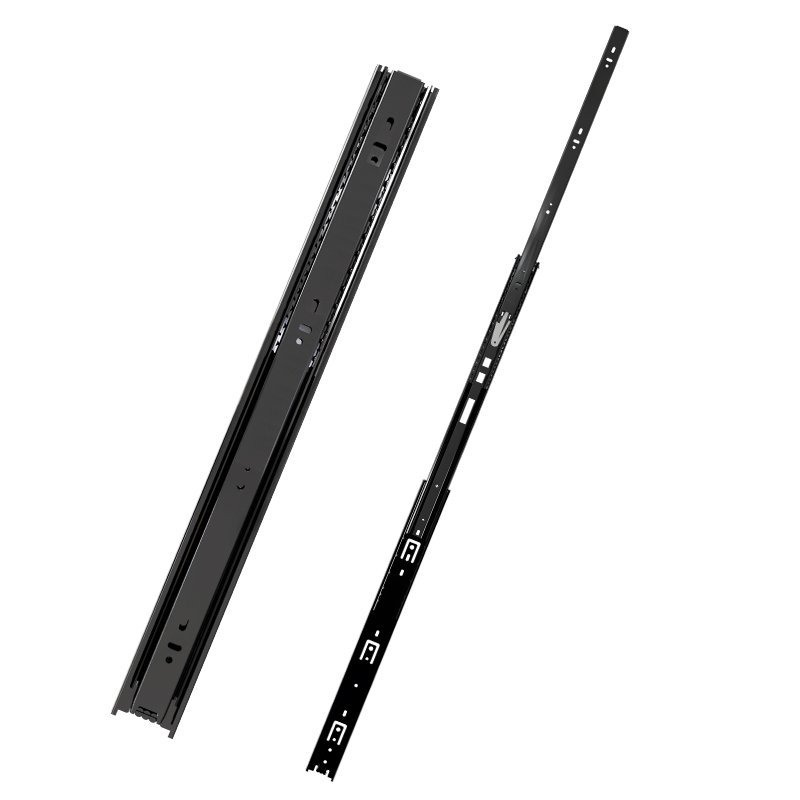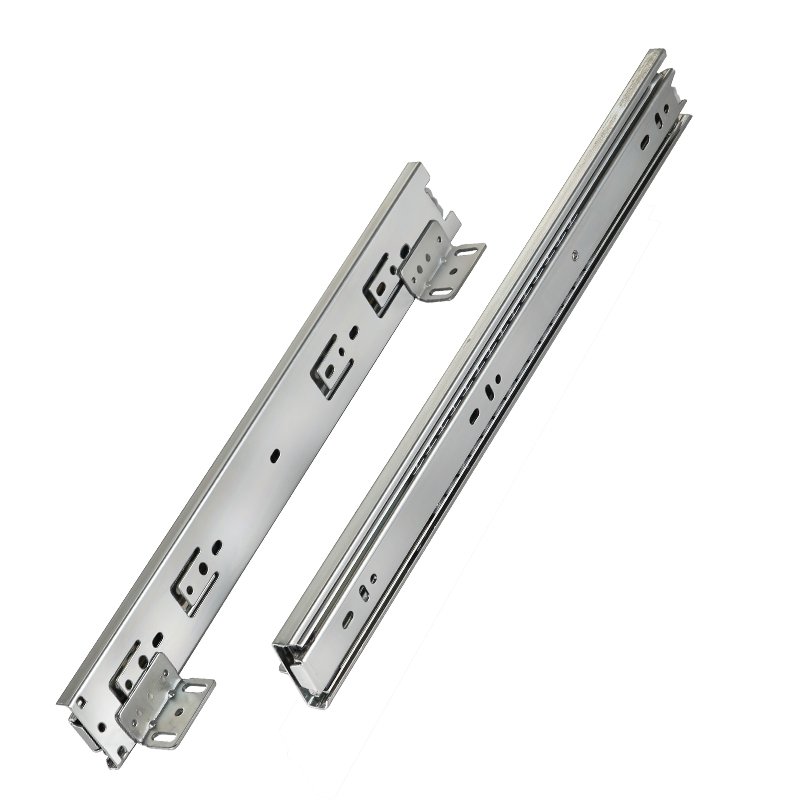Drawer Slides Manufacturer
Aolisheng has over a decade of experience in manufacturing drawer slides. We provide various steel drawer slides (201, 304 stainless, Q235D) tailored for different applications. These options significantly expand the load capacity of your drawers. Our drawer slides include soft close drawer slides and push to open drawer slides. Additionally, we have upgraded the number of steel balls to ensure your drawers operate more smoothly and are more durable.
Drawer Slides Catalog
Drawer Slides by Application
Drawer slides are designed with specific features and materials tailored to different application requirements and environments. For instance, heavy-duty drawer slides are chosen for applications requiring high load-bearing capacity, while aesthetics and ease of operation may be emphasized in home furnishings.
Drawer slides play a crucial role in various applications, including but not limited to:
Furniture
Drawer slides are widely used in various types of furniture such as kitchen cabinets, wardrobes, bedside tables, and storage units. They ensure smooth opening and closing of drawers, providing convenient storage solutions.
Office Furniture
Desks, filing cabinets, bookshelves, and other office furniture often use drawer slides to facilitate easy access and organization of files and office supplies.
Commercial Equipment
Drawer slides are found in cash registers, display cabinets, store shelves, and other commercial equipment for storing goods, documents, and cash-handling devices.
Types of Drawer Slides

Soft Close Drawer Slide

Adjustable Drawer Slide

Push To Open Drawer Slide
Contact Our Drawer Slides Engineers
Not sure which type of drawer slide is right for your product? Interested in learning more details about our products? Looking to customize your drawer slides? Click the button below to contact us, and we’ll provide the best solution tailored for you.
We Look Forward To Your Contact
AOLISHENG is your trusted global partner for high-quality drawer slide and hinges production, with strategic factories worldwide and professional local service teams. Partnering with AOLISHENG ensures efficient project delivery, robust supply chains, expert technical support, and a thriving customer base.
FAQ
What are drawer slides called?
Drawer slides, also known as drawer glides or drawer runners, and sometimes slide rails, are mechanical devices that ensure smooth and reliable use of drawers by reducing friction and providing stable support. Purchasing drawer slides with locking, soft-close, and push-to-open functions can also achieve the desired drawer-opening effect.
What is the sliding part of a drawer called?
The sliding part of a drawer is often called a “slide” or “runner.” In a slide system, the specific sliding parts include:
1. Slide: The main component of the entire slide system, usually with two tracks fixed to the side of the drawer and the inside of the cabinet. Slides can be straight or have curves to accommodate different opening and closing needs.
2. Rollers/sliders: These are small parts installed on the slide that can reduce friction and allow the drawer to slide smoothly. Rollers are usually round and sometimes use steel balls or rollers to reduce friction.
3. Guide rails: Another component of the slide that guides and supports the drawer to keep it stable when opening and closing.
4. Damper: Some slide systems are equipped with dampers or buffers that can slowly slow down the drawer when closing, preventing banging sounds and excessive wear.
These components work together to ensure smooth and stable movement of the drawer.
How do I know what drawer slides to buy?
When choosing a drawer slide, you can consider the following factors:
1. Drawer load: Determine the maximum weight that the drawer needs to bear, and choose a slide model and load-bearing capacity that matches it.
2. Slide size: The length of the selected slide should be equal to the length of the drawer. If you can’t find the right size, you can choose a slide that is slightly shorter than the drawer, but never too short.
3. Slide type: Choose a pulley type, ball bearing type, straight rail type, etc., according to the smoothness of opening and closing and the noise requirements.
4. Drawer full opening function: If the drawer needs to be fully opened, choose a slide that supports full extension.
5. Installation method: Check the installation method of the slide to make sure it fits your cabinet structure.
6. Buffering function: If you need a quieter opening and closing experience, you can choose a buffered closing drawer slide.
7. Locking function: If you need to fix the extended drawer slide, such as to prevent the drawer from sliding out during vehicle driving, then you need to purchase Locking drawer slides.
What makes drawers slide better?
1. Choose high-quality slides: Choose high-quality slides, especially ball slides, which usually have better-sliding performance and longer service life.
2. Regular maintenance and cleaning: Clean the dust and debris on the slides regularly to prevent them from causing friction or jamming. Use a suitable lubricant (such as silicone oil or a special slide lubricant) and apply it to the slides and rollers to reduce friction and make the drawer slide more smoothly.
3. Adjust the slides: Make sure the slides are installed correctly and adjusted to the appropriate position. Unbalanced or improperly installed slides may cause the drawer to get stuck or not smooth.
4. Check the load: Make sure the drawer load is within the load-bearing range of the slide. Overweight drawers may cause difficulty in sliding or damage the slides.
5. Avoid excessive pulling: Open and close the drawer gently and avoid excessive force to reduce the impact on the slide.
6. Check the alignment of the drawer with the slide: Make sure the drawer is aligned accurately with the slide. If the drawer is not aligned with the slide, it may cause jamming or not smooth.
7. Keep the environment dry: avoid water or moisture inside the slide rails and drawers to prevent the slide rails from rusting or the lubricant from becoming ineffective. Alternatively, choose stainless steel slide rails so that they can be used in humid environments or at the seaside.
Why use drawer slides?
1. Smooth sliding: Drawer slides provide a smooth path of motion, allowing drawers to open and close smoothly, reducing friction and jamming.
2. Load-bearing capacity: Drawer slides can withstand a certain amount of weight, ensuring that drawers can operate stably even when they are full of items. Some heavy-duty drawer slides can also support very heavy drawers, suitable for large storage cabinets or workbenches.
3. Increased service life: Good drawer slides can reduce direct friction between drawers and cabinets, thereby reducing wear and extending service life.
4. Improved function: Slides can make drawers fully or partially open, providing greater access and convenience. Slides with buffered closing can also slowly decelerate when the drawer is closed, reducing the impact sound.
5. Improved safety: Some slide designs have a self-locking function that can lock the position when the drawer is fully opened or closed, preventing accidental sliding and increasing safety.
6. Beauty and neatness: Slides can be hidden inside drawers and cabinets, making the drawer look neater and not exposing additional mechanical parts.
7. Adapt to multiple applications: Slides can be used in a variety of furniture and equipment, such as kitchen cabinets, office desks, wardrobes, etc., providing a wide range of application possibilities and increasing the possibility of other uses of furniture or equipment.
What is the best position for drawer slides?
The optimal position of the drawer slide should ensure the stability and smoothness of the drawer when opening and closing.
1. Horizontal alignment: The slide should be installed horizontally. If the slide is not level, it will cause the drawer to jam or wobble when opening or closing.
2. Correct height: Generally, the slide should be installed on the side of the drawer, a certain distance from the bottom of the drawer. This can maintain the stability of the drawer and evenly distribute the weight. The installation position of the slide is generally in the upper 1/3 or lower 1/3 of the drawer side.
3. Flush with the side: The slide should be installed flush with the side of the drawer to ensure that the drawer can slide smoothly on the track. If the slide is too low or too high, it may cause the drawer to not open or close completely.
4. Load considerations: Make sure the slide is installed in a position that can bear the weight of the drawer. Especially for larger drawers, the slide needs to have sufficient load-bearing capacity.
5. Spacing: The spacing between the slide and the side of the drawer should be uniform. Generally, the gap between the slide and the drawer should be kept at 1/16 to 1/8 inch (about 1.5 to 3 mm) to ensure smooth sliding and avoid jamming.
6. Check the manufacturer’s recommendations: Different types of slides (such as roller slides, ball-bearing slides, etc.) may have different installation requirements. Refer to the installation instructions provided by the slide manufacturer and follow the recommended installation location and method.













